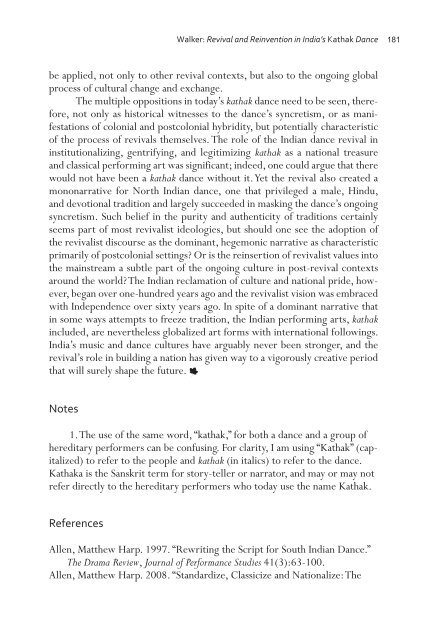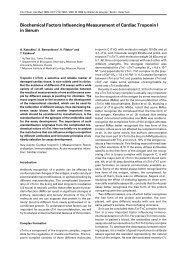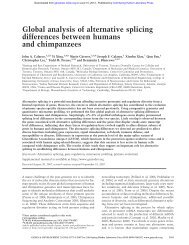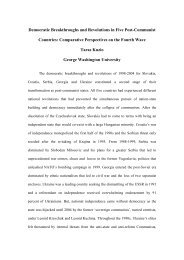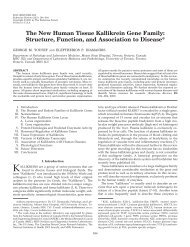180 MUSICultures 37opposition” to the Raj, <strong>of</strong>fer<strong>in</strong>g a tangible way to reclaim national self-esteemwhile fight<strong>in</strong>g for political <strong>and</strong> geographical autonomy. Yet, the ma<strong>in</strong>streamversus authentic equals colonial versus <strong>in</strong>digenous breaks down fairly quicklyas, <strong>in</strong> the Indian context, the <strong>revival</strong> soon became the ma<strong>in</strong>stream <strong>and</strong> <strong>in</strong>deedhad that goal from the beg<strong>in</strong>n<strong>in</strong>g. Classical kathak, particularly as represented<strong>and</strong> taught through the leaders <strong>of</strong> the hereditary families <strong>and</strong> their immediatedisciples, has now itself become hegemonic <strong>and</strong> forms a seem<strong>in</strong>gly unassailablecore <strong>of</strong> authenticity <strong>and</strong> authority. Yet, it is too simplistic to see the alterations<strong>of</strong> centre as an uncomplicated series <strong>of</strong> status exchanges because the<strong>revival</strong>, orig<strong>in</strong>ally the marg<strong>in</strong>alized tradition dur<strong>in</strong>g colonialism, itself becamethe ma<strong>in</strong>stream. Subsequently, the middle class women <strong>dance</strong>rs central to theprocess <strong>of</strong> <strong>revival</strong> became <strong>in</strong> some ways marg<strong>in</strong>alized <strong>in</strong> turn as the hereditarymen were established as authorities. Now, <strong>in</strong> what might be called thepost-<strong>revival</strong> context, those who dare to claim that kathak (the <strong>dance</strong>) shouldmove beyond what the authorities teach as authentic are the new marg<strong>in</strong>. Butsuch oppositions <strong>and</strong> changes <strong>in</strong> authority <strong>and</strong> control seem characteristic <strong>of</strong>North Indian <strong>dance</strong> long before its appearance as kathak <strong>in</strong> the 1930s. Transformations<strong>in</strong> identity, status, <strong>and</strong> ownership, not to mention the divisions <strong>and</strong>fusions <strong>of</strong> male <strong>and</strong> female performance practice, rhythmic <strong>and</strong> narrative repertoire,<strong>and</strong> secular <strong>and</strong> sacred <strong>in</strong>tent, po<strong>in</strong>t towards an artistic context wherechange <strong>and</strong> shifts <strong>in</strong> power have long seemed the most reliable constants.One answer surely lies <strong>in</strong> mov<strong>in</strong>g beyond the concept <strong>of</strong> opposition, <strong>and</strong>this is where postcolonial theory perhaps has someth<strong>in</strong>g to <strong>of</strong>fer. Although,as Jefferess (2008) po<strong>in</strong>ts out, the framework <strong>of</strong> resistance (occupied versusoccupier) is central to postcolonial criticism, he <strong>and</strong> other scholars such asRoy (2007) <strong>and</strong> G<strong>and</strong>hi (1998) also emphasize the unavoidable hybridity aris<strong>in</strong>gfrom enforced <strong>and</strong> ongo<strong>in</strong>g cultural <strong>in</strong>teraction. Embrac<strong>in</strong>g hybridity as acentral consequence <strong>of</strong> cultural exchange can mean mov<strong>in</strong>g beyond diversityor multiculturalism <strong>and</strong> their attendant qualities <strong>of</strong> exoticism <strong>and</strong> otherness.It also means mov<strong>in</strong>g beyond conceptions <strong>of</strong> cultural purity or authenticity<strong>and</strong> their attendant assertions <strong>of</strong> superiority. I am not sure if embrac<strong>in</strong>g an“ethics <strong>of</strong> hybridity” will lead to the type <strong>of</strong> global human underst<strong>and</strong><strong>in</strong>g thatscholars like Bhabha (1994) <strong>and</strong> G<strong>and</strong>hi (1998) tentatively suggest it could,but the idea itself certa<strong>in</strong>ly <strong>of</strong>fers a way out <strong>of</strong> the “totaliz<strong>in</strong>g b<strong>in</strong>aries” that focusonly on opposition <strong>and</strong> difference. A postcolonial theory <strong>of</strong> <strong>revival</strong> wouldhave to conceptualize the <strong>revival</strong> <strong>and</strong> the post-<strong>revival</strong> contexts as <strong>in</strong>extricablywoven <strong>in</strong>to ongo<strong>in</strong>g socio-political process, hybrid rather than oppositional,<strong>and</strong> simultaneously transform<strong>in</strong>g <strong>and</strong> transformed by the ma<strong>in</strong>stream like the“mutual transformation <strong>of</strong> colonizer <strong>and</strong> colonized” (G<strong>and</strong>hi 1998:40). Thisis undoubtedly the process <strong>of</strong> the Indian cultural <strong>revival</strong>, <strong>and</strong> perhaps should
Walker: Revival <strong>and</strong> Re<strong>in</strong>vention <strong>in</strong> India’s <strong>Kathak</strong> Dance181be applied, not only to other <strong>revival</strong> contexts, but also to the ongo<strong>in</strong>g globalprocess <strong>of</strong> cultural change <strong>and</strong> exchange.The multiple oppositions <strong>in</strong> today’s kathak <strong>dance</strong> need to be seen, therefore,not only as historical witnesses to the <strong>dance</strong>’s syncretism, or as manifestations<strong>of</strong> colonial <strong>and</strong> postcolonial hybridity, but potentially characteristic<strong>of</strong> the process <strong>of</strong> <strong>revival</strong>s themselves. The role <strong>of</strong> the Indian <strong>dance</strong> <strong>revival</strong> <strong>in</strong><strong>in</strong>stitutionaliz<strong>in</strong>g, gentrify<strong>in</strong>g, <strong>and</strong> legitimiz<strong>in</strong>g kathak as a national treasure<strong>and</strong> classical perform<strong>in</strong>g art was significant; <strong>in</strong>deed, one could argue that therewould not have been a kathak <strong>dance</strong> without it. Yet the <strong>revival</strong> also created amononarrative for North Indian <strong>dance</strong>, one that privileged a male, H<strong>in</strong>du,<strong>and</strong> devotional tradition <strong>and</strong> largely succeeded <strong>in</strong> mask<strong>in</strong>g the <strong>dance</strong>’s ongo<strong>in</strong>gsyncretism. Such belief <strong>in</strong> the purity <strong>and</strong> authenticity <strong>of</strong> traditions certa<strong>in</strong>lyseems part <strong>of</strong> most <strong>revival</strong>ist ideologies, but should one see the adoption <strong>of</strong>the <strong>revival</strong>ist discourse as the dom<strong>in</strong>ant, hegemonic narrative as characteristicprimarily <strong>of</strong> postcolonial sett<strong>in</strong>gs? Or is the re<strong>in</strong>sertion <strong>of</strong> <strong>revival</strong>ist values <strong>in</strong>tothe ma<strong>in</strong>stream a subtle part <strong>of</strong> the ongo<strong>in</strong>g culture <strong>in</strong> post-<strong>revival</strong> contextsaround the world? The Indian reclamation <strong>of</strong> culture <strong>and</strong> national pride, however,began over one-hundred years ago <strong>and</strong> the <strong>revival</strong>ist vision was embracedwith Independence over sixty years ago. In spite <strong>of</strong> a dom<strong>in</strong>ant narrative that<strong>in</strong> some ways attempts to freeze tradition, the Indian perform<strong>in</strong>g arts, kathak<strong>in</strong>cluded, are nevertheless globalized art forms with <strong>in</strong>ternational follow<strong>in</strong>gs.India’s music <strong>and</strong> <strong>dance</strong> cultures have arguably never been stronger, <strong>and</strong> the<strong>revival</strong>’s role <strong>in</strong> build<strong>in</strong>g a nation has given way to a vigorously creative periodthat will surely shape the future.Notes1. The use <strong>of</strong> the same word, “kathak,” for both a <strong>dance</strong> <strong>and</strong> a group <strong>of</strong>hereditary performers can be confus<strong>in</strong>g. For clarity, I am us<strong>in</strong>g “<strong>Kathak</strong>” (capitalized)to refer to the people <strong>and</strong> kathak (<strong>in</strong> italics) to refer to the <strong>dance</strong>.<strong>Kathak</strong>a is the Sanskrit term for story-teller or narrator, <strong>and</strong> may or may notrefer directly to the hereditary performers who today use the name <strong>Kathak</strong>.ReferencesAllen, Matthew Harp. 1997. “Rewrit<strong>in</strong>g the Script for South Indian Dance.”The Drama Review, Journal <strong>of</strong> Performance Studies 41(3):63-100.Allen, Matthew Harp. 2008. “St<strong>and</strong>ardize, Classicize <strong>and</strong> Nationalize: The


